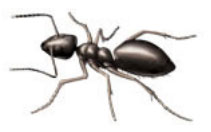Odorous House Ants

These ants come by their name logically. When you crush this ant it gives off a pungent odor of rotten coconuts. They are our most difficult ant to control. Odorous House Ants are found throughout the United States with very large colonies, anywhere from several hundred to 100,000 ants.
They are monomorphic, meaning that they are of the same size. Their nests consist of multiple queens and each of them can only produce one egg per day. It is assumed that they mate inside AND outside the nest, yet they do swarm from May through mid-July.
The development time of the complete life cycle (egg to adult) is anywhere from 34 to 84 days in the warm summer months and as long as 6 to 7 months during the colder winter months. In a year a colony will usually produce 4-5 generations. The workers and queens will live for several years, whereas the males die within a few days after emergence.
They are docile among other colonies. Now as for where you will find them in your home; they are normally within your wall voids - preferring locations around hot water pipes and heaters, crevices around sinks, cupboards… Notice that these are all water areas. When they come out and you see them inside, they are out looking for water.
After getting enough water, they will disappear back in your wall void. When they need more water again, they will reappear. So when you don’t see them, it doesn’t necessarily mean that you have gotten rid of them. They prefer a diet of sweets, but will also eat foods with high protein and grease as in meats and cheeses.
This explains why many people will refer to them as ‘sugar’ or ‘grease’ ants. They actually will go for either. Locations outside will be under objects, although they are also located in nests of larger ants. Their diet outside consists of insects, seeds, honeydew and plant secretions. Their preference is honeydew so they farm the insects that secrete the honeydew.
Those insects include plant lice (otherwise known as aphids), scale insects, mealy bugs, etc. When their supply of honeydew is reduced, usually by rainy weather or when the leaves are falling in the autumn, they will enter buildings. A funny characteristic they have is their reaction to being alarmed. They will run around in an erratic manner with their abdomens raised up, releasing the coconut-like odor pheromone. This odor will attract more of these ants to the location.
For further information, click on the link below.
Courtesy of Washington State University Extension




 Follow
Follow

